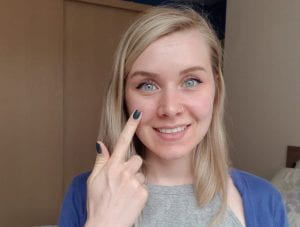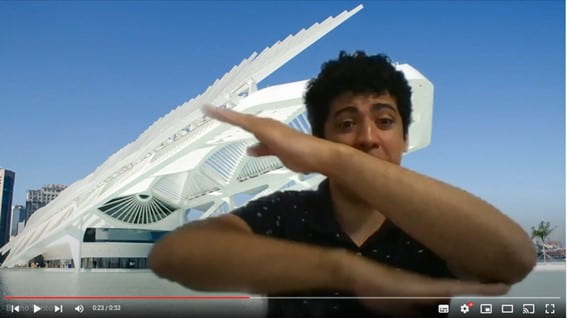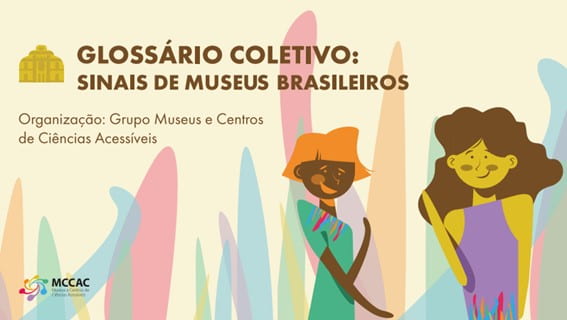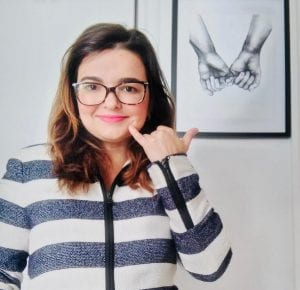
About the Author
Gabriela Sehnem Heck is a Ph.D. candidate in education at the Pontifical Catholic University of Rio Grande do Sul (PUCRS), a Coordenação de Aperfeiçoamento de Pessoal de Nível Superior grantee and a member of the research group Accessible Science Museums and Centers. She studies aspects related to the inclusion of d/Deaf people in museums and topics on science education for people with disabilities.
Jessica Norberto Rocha is a Science Communicator at Cecierj Foundation, a Young Scientist of Rio de Janeiro State FAPERJ, and a Fulbright researcher at the Museum of Science (Boston). She chairs the research group Accessible Science Museums and Centers and is a Master’s in Science, Technology, and Health Communication professor at the Oswaldo Cruz Foundation (Fiocruz).
This project is sponsored by FAPERJ (Fundação de Amparo a Pesquisa do Estado do Rio de Janeiro), through Jessica Norberto Rocha’s Young Scientist of the State of Rio de Janeiro grant. We would like to thank everyone who participated in creating the glossary: the video protagonists who sent the museums’ signs and museum and science centers’ staff. Also, we extend our gratitude to group MCCAC members: to Letícia Marinho, Lucas Jardim Escamilha, and Rodrigo da Rocha Machado, who made the audio description; to Marcelle Pita de Sousa do Carmo, who, together with Gabriela Heck, translated and subtitled the videos; to Willian Vieira de Abreu, who was responsible for the HTML version of the website; to Bruno Ramos, who made the glossary opening video; to Daniel Monteiro, who made the invitation video; to Julia Norberto Rocha, who made the illustration; to Dolores Daniela Affonso who made the audio description consultancy.
Museums and Deaf Population in Brazil
Creating a Collective Glossary of Museum Signs in Brazilian Sign Language
We’ve been fascinated that museums, science centers, zoos, planetariums, botanical gardens and other similar places are allied to the informal science learning process. They offer the opportunity for any citizen, of any age, from babies to older adults, to engage in their community’s cultural and scientific life. Museums offer multimodal and immersive exhibits that can provide unforgettable experiences to visitors, facilitating the connection of emotions to a learning environment different from classrooms and schools.
Have you ever imagined wanting to visit one of those places in your country but not being able because you can’t communicate in your own language? When we visit a museum, as hearing persons and in our mother language, we hardly face communication barriers. Sometimes a communication problem can happen because it is a natural process of the languages themselves—a person speaks too fast or too low or use a vocabulary we are not familiar with. This is easily solved by asking the interlocutor to repeat or rephrase it. If you’re a foreign visitor, you probably will find materials translated into English or other languages and bilingual educators or visitor assistants.
In Brazil, this situation is faced daily by d/Deaf people (we use deaf, in lower case, to refer to a person which have a hearing loss and Deaf, with a capital D, to refer to individuals who identify as a member of the Deaf Community) that communicate through Brazilian Sign Language (Libras) and do not have Portuguese as their dominant language. As researchers and practitioners in science education and communication, we receive countless reports by the d/Deaf that they feel like foreigners in their own country. They usually narrate these experiences with a tone of frustration, especially when they discover that the museum provides materials in foreign languages but do not in Libras—an officially recognized language in Brazil since 2002.
Unfortunately, the universal appeal of interactive learning does not mean universal access to these spaces in Brazil and elsewhere in Latin America. Beyond the communication barrier, sometimes the barriers are social and economic; sometimes they involve identity or representational issues; sometimes it’s a matter of physical accessibility, according to the study, “Investigating Accessibility in Latin American Science Museums and Centers.” There’s a demonstrated need for greater accessibility in these spaces, particularly in hopes of improving communication with the D/deaf audience in science education and promoting the creation and appropriation of new scientific signs in Libras.
Looking back to the history of the education of d/Deaf people in Brazil, we can see that, although there has been significant traction in their fight for greater access and rights, a substantial portion of the community is still excluded from quality schooling processes, which culminates in low literacy and low engagement with science topics. D/deaf people are under-involved in scientific studies, and subsequently, many scientific words in Portuguese do not have a corresponding sign in Libras. Science museums are not exempt from this reality: there is a lack of signs in Libras to refer to each organization. To mention or refer to a particular museum, often, the d/Deaf person needs to spell each letter of the institution’s name (called dactylology), which creates a barrier and a distance—both symbolically and materially—between d/Deaf individuals and the museum.
Numerous accessibility plans are being developed to broaden the participation of people with disabilities in museums, as seen in the Guide to Accessible Science Museums and Centers in Latin America and the Caribbean. The most common strategies to include d/Deaf visitors involve Portuguese subtitles, Libras interpreters and translated videos and multimedia in Libras. Nevertheless, we still find barriers in having the d/Deaf in the scientific field due to the absence of scientific signs or even the museums’ names in Libras.
For museums to have associated signs, a “baptism” must occur: baptizing is when a person or group of people belonging to the Deaf Community creates a sign to refer to a person, a place, an object, etc. Museums with signs in Libras are potentially more accessible as they show interest in receiving d/Deaf visitors; nevertheless, it is wasteful for an institution to have signs in Libras if it is not known or visited by the Deaf Community. This generates a new question for researchers: how can we maximize engagement and exposure to these efforts?
To tackle this concern, our research group called Accessible Science Museums and Centers (MCCAC) launched, in 2021, an innovative project to develop a collective glossary of museums’ and science centers’ signs in Libras. Our group produced a video invitation in Libras, captioned in Portuguese, and populated it across social media and the organizations’ mailing lists. We also directly contacted 137 museums and science centers via e-mail and social media and asked for support, in the marketing, of the Brazilian Association of Science Centers and Museums (ABCMC) and the Brazilian Association of Zoos and Aquariums (AZAB). The call was open to all Brazilians but was primarily focused on d/Deaf people, interpreters, teachers of Libras and museum staff. It remained open for three months, from May to September 2021. For those who are yet to be baptized, the group offers to organize actions to promote the creation of signs and get in touch with the Deaf Community. In addition, we are continuously offering free workshops and courses aimed at science communicators, science educators, and museums staff on the importance of accessible alternatives to increase scientific culture.
To participate in creating the glossary, a person from anywhere in the country should send a video to MCCAC with the sign of any museum they know. Participants are instructed to record a horizontal video, introduce themselves and the museum’s location (the city and state) and show the signal, all in Libras.

Bruno Santos is demonstrating the “Museu do Amanhã” sign in Libras. In the background, there is a photo of the museum in Rio de Janeiro, Brazil. Bruno makes the sign with both arms; the left is lying horizontally, in front of his bust, in the neutral space, while the other arm is positioned diagonally, with the elbow resting in the left hand. Bruno is a member of the deaf community making the sign of the Museum where he works as an educator.
We obtained 41 video responses with signs. Four people sent signs of the same two museums, and we included all of them because of its representativeness. We have, so far, received signs for 39 different museums. We highlight that 24 museums answered our call by e-mail, stating that they do not have a signal or do not know if they have it, demonstrating a lack of engagement with the d/Deaf audience.
A total of seven out of the 26 Brazilian states and federal districts are represented in the glossary: Ceará, Minas Gerais, Pará, Pernambuco, Rio de Janeiro, Rio Grande do Sul and São Paulo. Most of the signs received were from museums in Rio de Janeiro (16), followed by Minas Gerais (9) and São Paulo (7). These three states belong to the southeast region: the region with the highest density of museums in Brazil, according to data from the Brazilian Association of Science Centers and Museums, consistent with the most extensive participation in the Glossary.
Geographic divisions further proved obstructing given the phenomenon of “regionalism:” each region presents different signs for the same word, a fact that can interfere with the interpretation of the message and the assembly of a standardized glossary of words. Ultimately, our goal with the glossary is to help address a few of the many gaps in access to these spaces, ranging from linguistic to geographic to socioeconomic. To tackle this issue, we are working with specific museums of these underrepresented regions in the Glossary, offering assistance in broadening their audience and getting closer to the d/Deaf population.
The first edition of the glossary went on the MCCAC group’s YouTube channel and website in September 2021. It is free to access and is entirely in Libras, with a Portuguese translation in the caption and audio description. This last strategy was developed to reach not only the d/Deaf population and people who use screen-reading software but also people who do not know Libras: blind people, people with low vision, people with intellectual disabilities, anyone who speaks or gestures in Portuguese.

This photo represents a cover of the glossary in yellow background and a title in brown. Above, a museum icon. In the lower half, an illustration of two women on deformed colored figures: one has brown skin and orange hair, the other yellow skin and brown hair; they smile and wave. At the bottom, the logo of the group Accessible Science Museums and Centers.
The glossary remains open; we continue to receive videos and add them to the following editions. Interestingly, right after the launch, some museums felt the need to get in touch to send their signal, demonstrating that the online dissemination of Brazilian museum signs in Libras had an immediate impact on the interest of other institutions in presenting or even creating their own signs. We receive questions from people about how they can create a sign for their institution. Above all, we emphasize that signs should be created by a member of the Deaf Community in the region who is familiar with the physical characteristics and attends the institution. The signs are made to emulate the physical features of the place, but material architecture is not the exclusive source of their inspiration.
Brazil has undergone an enormous economic and political crisis affecting science, culture and education in the past few years. Added to this scenario, the pandemic closed museums in March 2020, and most have not reopened yet. Consequently, many museums are now threatened and trying to survive this arid context. Not all museums have websites and e-mails available online, so it was challenging to communicate with them. Of the museums contacted, more than half did not respond to any message, so we do not know if they did not receive the message or if they just chose not to respond. While the constraints presented by a pandemic may have posed difficulties for many, including our progress on the assembly of this glossary, we are also faced with a moment where we have the opportunity to make sure that when doors to these spaces reopen, they truly reopen for all.

Jessica Norberto Rocha
More Student Views
Of Salamanders and Spirits
I probably could’ve chosen a better day to visit the CIIDIR-IPN for the first time. It was the last week of September and the city had come to a full stop. Citizens barricaded the streets with tarps and plastic chairs, and protest banners covered the walls of the Edificio de Gobierno del Estado de Oaxaca, all demanding fair wages for the state’s educators. It was my first (but certainly not my last) encounter with the fierce political activism that Oaxaca is known for.
Public Universities in Peru
Visits to two public universities in Peru over the last two summers helped deepen my understanding of the system and explore some ideas for my own research. The first summer, I began visiting the National University of San Marcos (UNMSM) to learn about historical admissions processes and search for lists of applicants and admitted students. I wanted to identify those students and follow their educational, professional and political trajectories at one of the country’s most important universities. In the summer of 2025, I once again visited UNMSM in Lima and traveled to Cusco to visit the National University of San Antonio Abad del Cusco (UNSAAC). This time, I conducted interviews with professors and student representatives to learn about their experiences and perspectives on higher-education policies such as faculty salary reforms and the processes for the hiring and promotion of professors.
Post-Secondary Education Access in Peru
Over the summer, I visited four public schools in Peru located in two regions, about 1,200 miles apart from each other. I interviewed teachers, principals and high school juniors and seniors. I wanted to discover their perspectives on perceived opportunities and barriers for students to plan for and fulfill their higher education goals. I also interviewed the superintendent at each school district to learn about local initiatives aimed at decreasing barriers to higher education transition.




